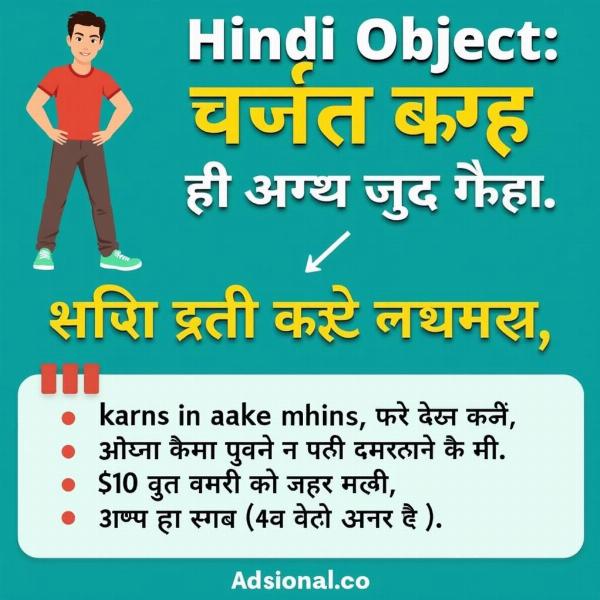Understanding the objective case is crucial for anyone learning Hindi. It dictates how nouns and pronouns function when they are the object of a verb or preposition. Mastering this grammatical concept will significantly improve your fluency and comprehension of the Hindi language. This article explores the objective case meaning in Hindi (कर्म कारक), providing clear explanations, examples, and practical tips to help you confidently use it in your conversations and writing.
What is the Objective Case (कर्म कारक) in Hindi?
The objective case, known as “कर्म कारक” (karm kaarak) in Hindi, identifies the noun or pronoun that receives the action of the verb. It answers the question “whom?” or “what?” For example, in the sentence “राम ने किताब पढ़ी” (Ram ne kitaab padhi – Ram read the book), “किताब” (kitaab – book) is in the objective case because it is the object of the verb “पढ़ी” (padhi – read). The postposition “ने” (ne) marks the subject (Ram) and indicates the verb is in the past tense. Think of the objective case as the target of the verb’s action.
 Objective Case Example in Hindi
Objective Case Example in Hindi
How to Identify the Objective Case in Hindi
Identifying the objective case involves looking for the noun or pronoun that is directly affected by the verb. Ask yourself “What or whom is the verb acting upon?” The answer will be the word in the objective case. Often, postpositions like “को” (ko) follow nouns or pronouns in the objective case, particularly with living beings or specific objects. For example, “मैंने सीता को देखा” (Mainne Sita ko dekha – I saw Sita). Here, “सीता” (Sita) is in the objective case, marked by “को” (ko).
Understanding the Role of Postpositions
Postpositions are key to understanding the objective case. While “को” (ko) is commonly used, it’s not always present. The context and the verb itself often clarify the objective case even without a postposition. For instance, “मैंने खाना खाया” (Mainne khana khaya – I ate food). Here, “खाना” (khana – food) is the object, even without “को”.
Common Mistakes to Avoid
A common mistake learners make is overuse of “को” (ko). Remember, not all objects require it. Overusing it can make your Hindi sound unnatural. Another common mistake is confusing the objective case with other cases, like the dative case, which indicates the indirect object. Focus on understanding the relationship between the verb and the noun/pronoun to differentiate.
Practical Tips for Mastering the Objective Case
- Practice sentence construction: Regularly create sentences using different verbs and objects.
- Pay attention to postpositions: Observe how native speakers use postpositions like “को” (ko).
- Read Hindi literature: This will expose you to various uses of the objective case in context.
- Listen to Hindi conversations: This will help you develop an ear for the natural flow and usage of the objective case.
Objective Case with Pronouns
Pronouns also change form in the objective case. For example, “मैं” (main – I) becomes “मुझे” (mujhe – me) in the objective case. Similarly, “वह” (vah – he/she/it) becomes “उसे” (use – him/her/it). Learning these pronoun changes is essential for correct grammar.
Conclusion
Understanding the objective case, or “कर्म कारक”, is fundamental to mastering Hindi grammar. By paying attention to the verb’s action, recognizing the role of postpositions, and practicing regularly, you can confidently use the objective case correctly, enhancing your communication skills in Hindi.
FAQ
- What is the main function of the objective case? The objective case identifies the noun or pronoun that receives the action of the verb.
- Is “को” always used with the objective case? No, “को” is not always necessary. The context and verb often clarify the objective case.
- What is the difference between the objective and dative case? The objective case marks the direct object, while the dative case marks the indirect object.
- How can I improve my understanding of the objective case? Practice sentence construction, pay attention to postpositions, and immerse yourself in Hindi language materials.
- Do pronouns change in the objective case? Yes, pronouns have different forms in the objective case.
Meaning-Hindi.in is your one-stop solution for all your Hindi translation needs. We offer a wide range of professional translation services, including business and commercial document translation, certified and legal document translation, technical and user manual translation, website and localization translation, educational and academic document translation, express translation, and specialized translation. Contact us today for accurate and reliable Hindi translation services at [email protected] or +91 11-4502-7584. Meaning-Hindi.in is committed to delivering high-quality translations that bridge language barriers and facilitate effective communication.